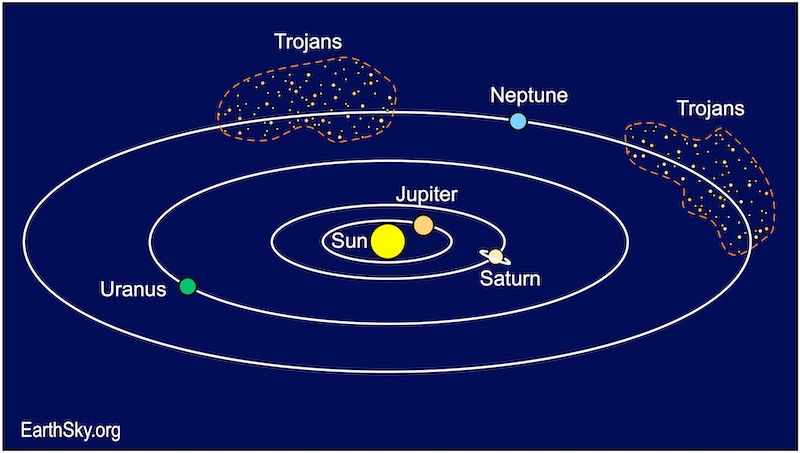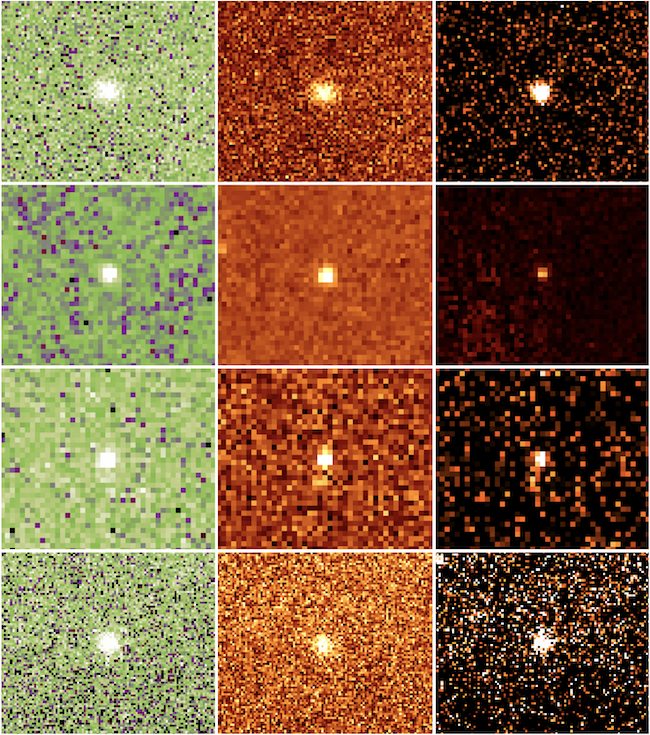
We tend to think of asteroids as large gray rocks, not much different from rocks on the moon. But some asteroids are more colorful. For example, some are reddish. That’s now known to be the case for a collection of 18 red asteroids orbiting at the stable Lagrangian points – the L-4 and L-5 points – in Neptune’s distant orbit around the sun. These asteroids are called Neptune Trojans. There are at least 28 known in all, so far. But because they’re so far from the sun, they are hard to study. That’s why an international group of researchers were excited to find that, of 18 Neptune Trojans studied so far, all are even redder than previously thought.
The Royal Astronomical Society announced this new study of Neptune Trojans on March 28, 2023. The scientists said there’s a broad spectrum of red coloring on the 18 asteroids, perhaps in two populations.
Neptune Trojans up to 50 miles wide
These asteroids are between 30 to 50 miles (50 and 100 km) in size. They’re located 60 degrees in front of, and 60 degrees behind, Neptune in its orbit, at a distance of around 2.8 billion miles (4.5 billion km) from the sun.
Bryce Bolin of NASA’s Goddard Space Flight Center led the new study. He and his colleagues had published their peer-reviewed findings in the Monthly Notices of the Royal Astronomical Society in late February.
And Bolin said in late March:
In our new work we have more than doubled the sample of Neptune Trojans studied with large telescopes. It’s exciting to find the first evidence of redder asteroids in this group.
So the Neptune Trojans don’t come in shades of gray. They come in shades of red.
Why are they so red?
But what makes these asteroids red? Scientists say they contain more volatile ices like ammonia and methanol. Those gases are very sensitive to heat. Closer in toward the sun, those ices would sublimate into gas. But since these asteroids are farther out from the sun, those gases remain as ices and create the red color.
The scientists said the Neptune Trojans’ presence – so far out from the sun – makes them like time capsules of the early solar system.
And they’re intrigued by the fact that there now appear to be at least two types of Neptune Trojan asteroids – with each type in different shades of red – presenting a dichotomy of sorts. The researchers said there’s a transition zone between the redder asteroids and the more neutral ones. But why? It could be that the redder asteroids initially formed even farther out in the solar system.
Later, Neptune’s gravity might have pulled the asteroids into Neptune’s stable Lagrangian points, where they remain today.
In an interesting twist, the researchers said this capture might have happened at the same time that Neptune itself was migrating outward from the sun, to its current location some 2.8 billion miles (4.5 billion km) from our local star.
Red asteroids in the outer solar system
The Neptune Trojans aren’t the only red asteroids in the outer solar system.
Astronomers refer to asteroids orbiting the sun beyond Neptune’s orbit as trans-Neptunian objects.
Previously, this same group of astronomers had also discovered redness among the trans-Neptunian objects.

But the 18 Neptune Trojans are unique
They said the newly studied asteroids differ from other known asteroids. Some now appear to be much redder in color than most asteroids. In fact, they are even redder than other previously known Neptune Trojans.
They’re also distinct from the Jupiter Trojan asteroids, that are closer to us and therefore better studied, and are known to have a more neutral color. As Bolin explained:
Because we have a larger sample of Neptune Trojans with measured colors, we can now start to see major differences between asteroid groups. Our observations also show that the Neptune Trojans are also different in color compared to asteroid groups even further from the sun. A possible explanation may be that the processing of the surfaces of asteroids by the sun’s heat may have different effects for asteroids at varying solar distances.
Telescopes in California, Hawaii and Chile
Astronomers gathered the new data about the asteroids over two years using the Wafer-Scale camera for Prime (WASP) camera on the Palomar Observatory telescope in California, the Gemini Multi-Object Spectrographs (GMOS) cameras at the International Gemini Observatory telescopes in Hawaii and Chile and the Low Resolution Imaging Spectrometer (LRIS) camera at the W. M. Keck Observatory in Hawaii.
Red asteroids in the asteroid belt, too
By the way, in 2021, scientists did report finding two distinctly red asteroids in the main asteroid belt between Mars and Jupiter.
The astronomers said they might have been trans-Neptunian asteroids that drifted inward closer to the sun.

Bottom line: Astronomers used a trio of telescopes to measure the “redness” of the Neptune Trojans, asteroids traveling in Neptune’s orbit. Turns out they’re redder than expected.
Source: Keck, Gemini, and Palomar 200-inch visible photometry of red and very-red Neptunian Trojans











